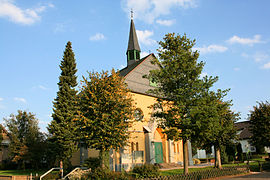Limbach (Asbach)
|
Limbach
Local community Asbach
Coordinates: 50 ° 41 ′ 6 ″ N , 7 ° 26 ′ 38 ″ E
|
||
|---|---|---|
| Height : | 286 m | |
| Residents : | 459 (Dec. 31, 2009) | |
| Incorporation : | March 16, 1974 | |
| Postal code : | 53567 | |
| Area code : | 02683 | |
|
Location of Limbach in Rhineland-Palatinate |
||
Limbach (dialect "Lempich") is a district of the local community Asbach in the district of Neuwied in northern Rhineland-Palatinate . The place is dominated by agriculture, but has the character of a residential community .
geography
The village is located in the Niederwesterwald northeast of the main town Asbach near the state border with North Rhine-Westphalia and the border with the Altenkirchen district . Limbach is connected to the Asbach district of Löhe and Landesstraße 255 via district road 61 and to the district of Sessenhausen via district road 70 .
history
The history of Limbach is closely linked to the history of the neighboring towns of Hussen and Löhe . The three places belonged to the "Altenhöver Zehnt ".
In the year 1222 a heathen empire of Limpach is as Ministeriale of Count Heinrich III. von Sayn at Blankenberg Castle witnessed a donation for the foundation of the Marienstatt Abbey . Later the family called themselves "Mant von Limpach" and was in the service of the Lords of Ütgenbach . “Mant” referred to a “judicial office” of the lower jurisdiction .
The first written mention of the place comes from the year 1370, when Rorich von Ütgenbach leased a farm in Limbach for 22 Malter oats and three Malter Korn. From 1515 on, the lords of Nesselrode were wealthy in Limbach.
The place belonged to the electorate of Cologne and the office of Altenwied and gave its name to the " Honnschaft Limbach". According to an inventory ordered by Cologne Elector and Archbishop Maximilian Heinrich in 1660, Limbach had seven courtyards. In 1787 there were 24 houses with 66 inhabitants, in 1808 there were 21 houses.
The rule of Kurköln in the region ended in 1803 after more than 500 years with the Reichsdeputationshauptschluss . The Electorate of Cologne area in this region was initially the Wied-Runkel assigned and came in 1806 due to the Act of Confederation, the Duchy of Nassau . The Limbach family was then subordinate to the administration of the Nassau office of Altenwied . After the treaties concluded at the Congress of Vienna , the area was ceded to the Kingdom of Prussia in 1815 .
Limbach became a municipality in the then newly formed district Neuwied in Koblenz and was supported by the mayor Asbach managed. According to a census from 1885, the municipality of Limbach and its districts had 906 inhabitants who lived in 197 residential buildings and 11 residential places . The community included the places Ditscheid , Graben , Hurtenbach, Hussen , Krumbach , Löhe , Parscheid (partially), Sessenhausen , Wester and Zurheiden .
In 1848 the first chapel in Limbach was built from private funds and dedicated to St. James . In 1868 the chapel was enlarged and the Rosary Queen became the patroness. The current church was built in 1889.
1874 Limbach got its own school and in 1931 its own post office Class II in the district of the post office Asbach, by the country post office of the post office from 1966 Linz was supplied.
Limbach with its districts was an independent municipality until March 16, 1974 and last had 1,105 inhabitants. The local community Asbach was re-formed on March 16, 1974 from it and the simultaneously dissolved communities Asbach (1,106 inhabitants) and Schöneberg (1,662 inhabitants) and part of the community Elsaff (1,022 inhabitants). In 1987 Limbach had 340 inhabitants.
Attractions
Are under monument protection:
- Catholic rectorate church Maria Rosenkranzkönigin , a three - axis neo - Gothic hall from 1889. The organ is from 1720 and for the most part still original.
- War memorial with a figure of Christ in the cemetery
- A small half-timbered - Quereinhaus 19th century.
school
Municipal Mayor
The municipal mayors since 1946 were:
- 1946–1948 Josef Marnett, Hussen
- 1948–1952 Johann Stroh, Krumbach
- 1952–1965 Johann Marnette, Hussen
- 1965–1969 Johann Hohn. Limbach
- 1969–1972 Johann Limbach, Zurheiden
- 1972–1974 Hermann Limbach, Zurheiden
Web links
Individual evidence
- ↑ a b c Josef Schäfer: History of the Asbacher Land , 1980, page 51 F.
- ↑ Nassauische Annalen: Jahrbuch des Verein für Nassauische Altertumskunde und Geschichtsforschung, Volume 9-10 , 1868, page 305
- ^ Community encyclopedia for the Kingdom of Prussia , 1885, page 42
- ^ Theo Winterscheid: From the history of the post in the Windhagener area. In: Windhagen - Ein Heimatbuch , Economica Verlag, Bonn 1994, pp. 113/114.
- ↑ State Statistical Office Rhineland-Palatinate, Official Municipal Directory 2006 ( Memento from July 18, 2011 in the Internet Archive ), page 169 (PDF; 2.1 MB)
- ^ State Statistical Office Rhineland-Palatinate - Official directory of the municipalities and parts of the municipality
- ↑ Informational directory of cultural monuments, Neuwied district , status: January 3, 2013, page 4 (PDF; 1.6 MB)
- ^ Local community Asbach (Ed.): Asbach / Westerwald. Pictures and reports from the last 200 years ; 1990, page 47



